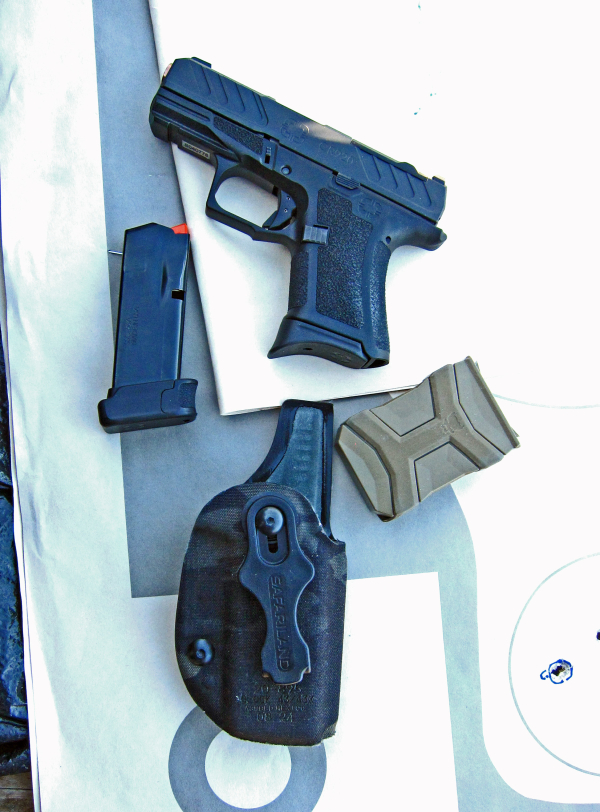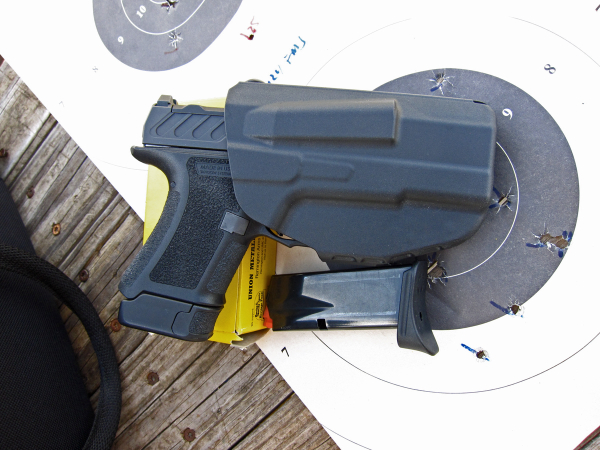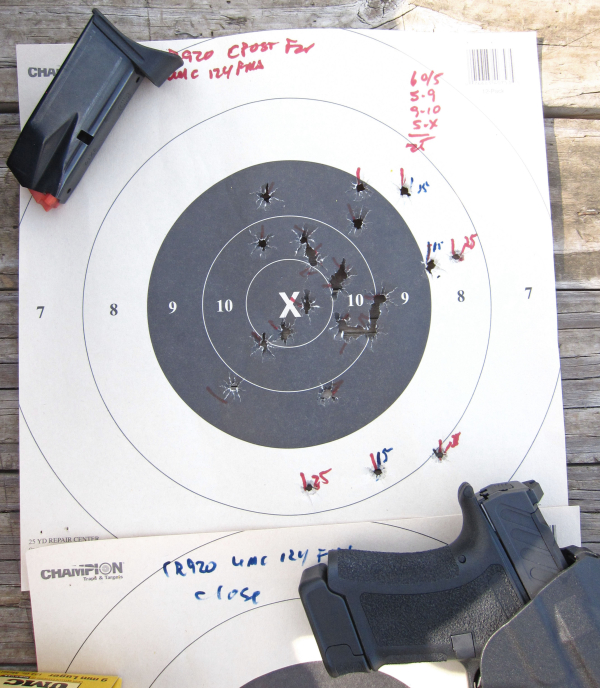(Editor’s Note: In the last issue, the question of practical uses of night vision and thermal imagers was raised. I’ve since been reminded that Gunsite Academy offers classes in practical use of such devices. Information can be found here. If you intend to use these things operationally, here’s a chance to train with them.)
In Shooting Wire, we featured the “first shots” of the Shadow Systems CR920 Foundation Pistol. With all the quality enhancements of the “elite” version and without cosmetics, the CR920 has shown itself to be quite accurate. The finicky feeding has been fading.
The frame is wonderfully ergonomic, well-textured. The sights are quite visible and the trigger is just fine, above par for a modern striker-fired auto.
I’d fired 86 rounds of ammo through the little beast on the first trip. There were stoppages from the gate. One stoppage was a round that fired – the round left the barrel, as I found after a pause in shooting to check the bore – that left the empty in the chamber. There wasn’t enough power to move the slide – not a gun problem.

For this trip, I set about shooting a pair of fifty-round qualification courses: the 2019 FBI course and the Kansas C-POST qualification. The targets were IALEFI-Q targets, older ones that I’d marked with a line around the “waist,” making the dimensions of the “bottle’s” top about the same as the FBI QIT-99 target.
The holster was the Safariland Species IWB holster in MultiCam Black. I’d just received it for evaluation.
The surface treatment doesn’t matter as much as the holster’s operational features. It’s a small “minimalist” IWB for 1 ½” belts. It can be adjusted for cant and ride height. It features passive trigger guard tension to keep the gun where it belongs. Made from SafariLaminate, it is suede lined to enhance fit, reduce draw “noise,” and has a sight channel for standard height sights.
I arrived at the range on a brisk 28° March morning. The wind played havoc with my already-compromised cardboard backer, so I spent some considerable time on target repair – combining my target backer with a less-shot cardboard reinforcement, using clamps and masking tape to hold the mess together.
The FBI course was first, using older stock Winchester “WinClean” hardball and the Safariland IWB holster. I experienced a few foul-ups but found I could shoot inside the target’s rings in a little over half the time allotted for the string … unless I had a stoppage. This happened on the last string of fire, at 25 yards, when I had a failure to eject. This caused me to go .02 second over time.
Still, the target scored 100% (FBI scoring) with four hits outside of the IALEFI target’s scoring rings. Not great, but the gun is new to me – and it’s a tiny 9mm.
On the C-POST course, I had a fail to feed using Winchester White box 115 gr. FMJ at the 15-yard line. I also pulled a hit off the bottle at 25 yards. Not my finest shooting.
I finished by shooting the FBI Instructor bullseye course. I used a B-8 repair center. I had one round off the repair center, a first for me. The remainder were in the scoring rings but not convincingly so. With nine hits outside the 9-ring, I managed to eke out a 261/300 … enough to get into instructor school.
It’d take more work to stay there.
Now for context: this is a micro-compact gun, allegedly far tougher to shoot than service- and service-compact guns. I managed to pull off an arguably clean run on a national class LE course, a “one down” on a state course and passed an instructor class bullseye course.
That’s with a gun that I lack complete familiarity with. But, over 200 rounds into it, I’m more familiar with it now than I was at the outset. That makes the break-in as much for the shooter as it does the gun. And the shooter break-in is something too seldom done with personal protection handguns.
It’s fun to shoot and not as tiresome as some micro-9s can be when shooting long courses of fire. I experienced no stoppages with the CR920 on the bullseye course which I shot with the (thus far very impressive) Magtech steel case 115 gr. FMJ ammo.


I followed up with another trip and some “old stock” ammo to shoot the state qual on a pair of B-8 repair centers. This is vastly tighter than shooting on the older FBI-Q target. My times were longish, but I was trying to stay in the bull. On this trip I had one round fail to go into battery. Otherwise, the CR920 ran like a champ. I had no hits off either B-8 (one target was for the ‘close range’ part of the course, about 3 yards back to 7 yards). The 10,15- and 25-yard stages were fired on a separate target. The holster this trip was a Safariland 7TS ALS Concealment Paddle Holster made for the G43X MOS. The photo of the “far” target shows some pretty good (though tardy) work.

I used the MDT Shot Timer I’d received last year (it’s now available from Shooters Global as the SG Timer). The upside, for me, is the easy-to-read display, the clip-on mount with a magnet attachment for the timer (I won’t be running and jumping to test its stability), the fact that it’s rechargeable with a USB-C cable and that the charge lasts for weeks.
It is “Blue Tooth” capable and I have the app on the phone. It can collect massive amounts of information – if you can decipher its use. The sensitivity of its microphone is adjustable and you can apparently preset drills, using the app to track performance. It even allows video to be taken from the phone during a drill.
I found it complicated, confusing and the buzzer – at 100% -- was very quiet. With amplified muffs and no one else around, it worked. After the range trip, I saw an ad from SG that demonstrated the “RO” feature: use it as an RO and it works like a regular timer.
Eureka! There’s something to try on the next outing. I think the lower-cost SG Timer GO would be more appropriate for my use, but I’ll try this in “RO” mode.
Meanwhile, the Shadow Systems CR920 Foundation has great possibilities – and it looks good too.
— Rich Grassi